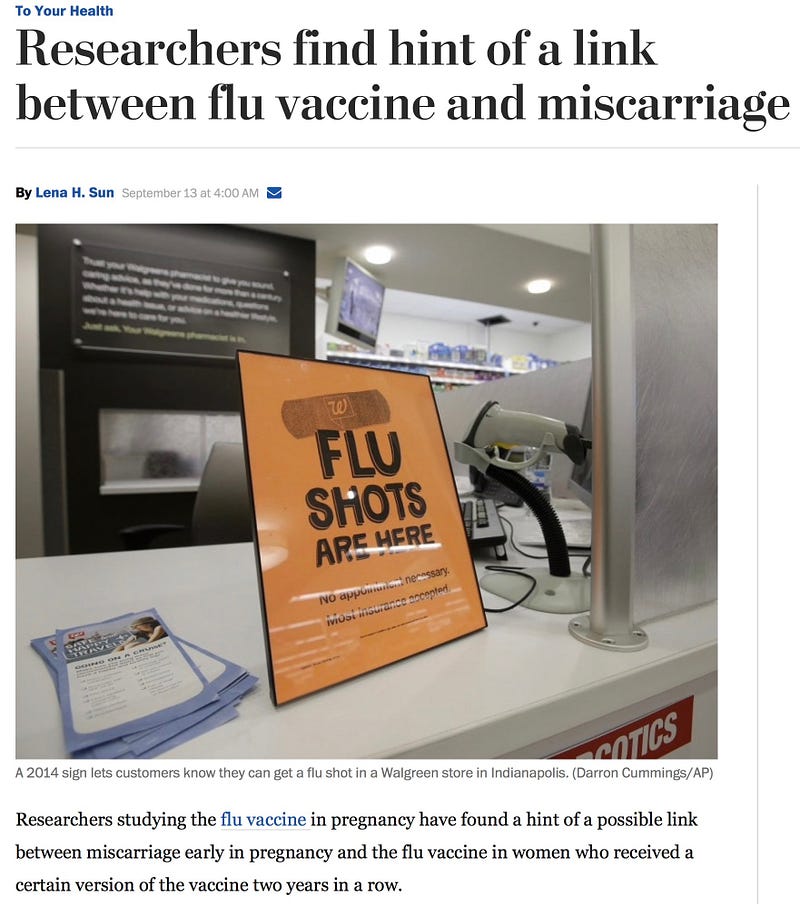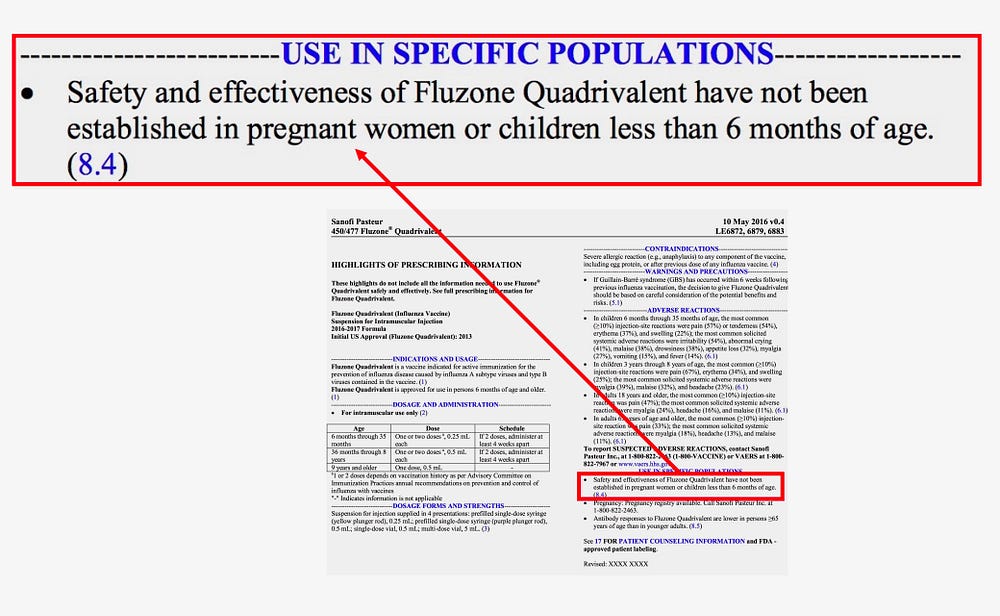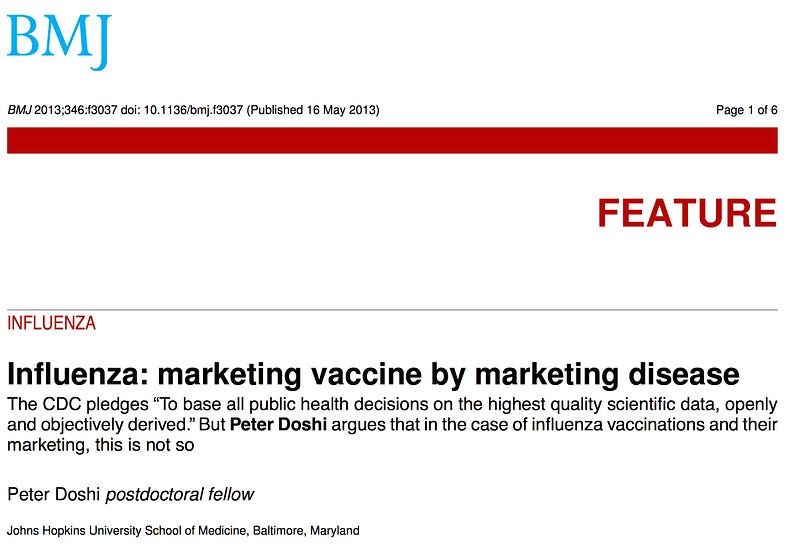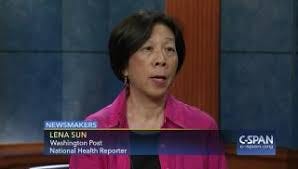BY J.B. HANDLEY September 13, 2017
The mainstream media is doing their best to minimize a devastating study showing a high correlation (7-fold) between flu vaccines and miscarriages. A review of the scientific literature shows a body of evidence that supports the new study’s conclusions. Why can’t we all just deal with the facts?

WASHINGTON, D.C. — Lena Sun, reporter for the Washington Post, had an unenviable task: cover a newly released study implicating the flu vaccine in spontaneous abortions (aka, miscarriages). The study, released today in the highly respected and prestigious journal Vaccine, has a title that will likely increase the stress level of pregnant women trying to figure out how to keep their baby safe:
Association of spontaneous abortion with receipt of inactivated influenza vaccine containing H1N1 pdm09 in 2010–11 and 2011–12
Like all good journalists working in the mainstream media, Ms. Sun’s challenge was to report on a potentially catastrophic new study that might hurt the primary source of advertising revenue for her employer: the pharmaceutical industry. And while I’ve seen a number of different ways for reporters to try and minimize the implications of damaging studies, Ms. Sun’s headline may just take the cake:

For those of you not steeped in the jargon of statistics or epidemiology, you’re going to have to take my word for it that “hint” is not a statistical term nor does “hint” in any way provide a specific assessment of risk. “Hint” is more like a word that you hope might keep people from reading your article.
(Imagine saying McDonald’s hamburgers provide a “hint” of spontaneous death or riding a rollercoaster provides a “hint” of lifelong paralysis…)
Despite Ms. Sun’s choice to minimize the significance of the study, the actual conclusions by the study authors were deeply troubling. In a nutshell, what the authors found is that women who had received an H1N1flu shot in the 2010–11 season and who then received a normal flu vaccine in the 2011–12 season were dramatically more likely to have a spontaneous abortion. How much more likely? Here’s what the study says:
“Among women who received pH1N1-containing vaccine in the previous influenza season, the aOR in the 1–28 days was 7.7 (95% CI 2.2–27.3); the aOR was 1.3 (95% CI 0.7–2.7) among women not vaccinated in the previous season.”
(Author’s note: soon after my article was published, the headline of Ms. Sun’s article was changed to remove the word “hint” although she is still using the word to describe the 7-fold relationship researchers found within the article itself.)
For those of you who need to brush up on your statistics (pretty much all of us), an odds ratio is “a measure of association between an exposure and an outcome. The OR represents the odds that an outcome will occur given a particular exposure, compared to the odds of the outcome occurring in the absence of that exposure.” In plain English, an odds ratio greater than 1 would tend to imply that two things are in fact linked (like tobacco use and lung cancer). What was the odds ratio for spontaneous abortion for women who had received an H1N1 shot in 2010–2011 and then a flu vaccine in 2011–12?
The study says 7.7, for those of you counting at home, that’s not a “hint”, that’s a giant disturbing alarm (which is why the damage control is being rolled out en masse today). Women who had received the two flu shots in successive seasons were almost 8x more likely to have a spontaneous abortion than those who had not — a 770% increase.
Ms. Sun compounds her minimization of a very serious conclusion by then saying something that’s simply not true:
The findings suggest an association, not a causal link, and the research is too weak and preliminary, experts said, to change the advice, which is based on a multitude of previous studies, that pregnant women should get a flu vaccine to protect them from influenza, a deadly disease that may cause serious birth defects and miscarriage.
It’s always ridiculous when I read things from reporters that say “multitude of previous studies” because I know that it’s pretty easy to verify whether or not that’s true. You see, every vaccine is required to have a package insert, and unlike a Washington Post reporter, the law requires package insert writers to tell the truth, which Sanofi Pasteur (a flu vaccine maker) did when they wrote this package insert for their flu vaccine one year ago, in 2016:

Ms. Sun, in the case of Sanofi’s flu vaccine, routinely given to pregnant women, the sum total of the “multitude” of safety studies done on the vaccine’s safety in pregnant women is ZERO, at least according to the product’s package insert written by the vaccine maker (and is true for every other flu vaccine).
Before I jump into the science on the flu vaccine, I need to mention that this whole issue of what impact getting flu vaccines in successive years does to people’s immune systems (and to an unborn fetus) is not new. In fact, it was actually a giant controversy in Canada just a few years ago. Here’s an article:
“Not only was there a vaccine mismatch with that dominant strain — H3N2 is responsible for about 90 per cent of all flu deaths, especially among the elderly — but researchers found that people who had been inoculated in previous years actually had a higher risk of coming down with the flu than those who typically didn’t get a shot.”
“‘That’s a controversial finding, obviously,’ said Skowronski, who led the study recently published in the journal Clinical Infectious Diseases. ‘But that’s not a reason for us to shy away from addressing it.’”
Scientists actually speak up, while CDC says pipe down
In the last week, two things happened that are starting to look less like a coincidence and more likely related to this miscarriage-flu shot study:
- A group of prestigious scientists wrote a withering critique of the opposition they experience when publishing studies that show negative outcomes for vaccines (it’s published in the same journal where the new flu shot study is published, Vaccine):
The authors write:
“Recently, the authors of many vaccine safety investigations are being personally criticized rather than the actual science being methodologically assessed and critiqued. Unfortunately, this could result in making vaccine safety science a ‘‘hazardous occupation”. Critiques should focus on the science and not on the authors and on the scientists that publish reasonably high-quality science suggesting a problem with a given vaccine. These scientists require adequate professional protection so there are not disincentives to publish and to carry out researches in the field. The issues for vaccine safety are not dissimilar to other areas such as medical errors and drug safety.”
2. Meanwhile, the U.S. Centers for Disease Control has issued a gag order on employees talking to the press, from an article yesterday in Axios.com:
The Centers for Disease Control and Prevention is trying to crack down on its employees’ conversations with the press, according to an internal email obtained by Axios. The message — sent by public affairs officer Jeffrey Lancashire and dated Aug. 31 — instructs all CDC employees not to speak to reporters, “even for a simple data-related question.”
What it said:
“Effective immediately and until further notice, any and all correspondence with any member of the news media, regardless of the nature of the inquiry, must be cleared through CDC’s Atlanta Communications Office,” Lancashire wrote. “This correspondence includes everything from formal interview requests to the most basic of data requests.”
I’ll let the reader draw their own conclusions on these two developments.
Let the science speak
So now you know that you may not get the truth about vaccine science from a Washington Post reporter. Well, what does the science actually say about flu shots? Here’s 10 published studies (and a bonus) that I hope will help you better understand this topic.

1. Influenza: marketing vaccine by marketing disease
Background: Johns Hopkins scientist and British Medical Journal editor delivers critique of the marketing and limited studies of flu vaccine.
Excerpt: “Closer examination of influenza vaccine policies shows that although proponents employ the rhetoric of science, the studies underlying the policy are often of low quality, and do not substantiate officials’ claims. The vaccine might be less beneficial and less safe than has been claimed, and the threat of influenza appears overstated.”
2. Comparison of VAERS fetal-loss reports during three consecutive influenza seasons: Was there a synergistic fetal toxicity associated with the two-vaccine 2009/2010 season?
Background: This study found the exact same flu vaccine/spontaneous abortion link when comparing the 2008–09 to the 2009–10 flu season.
Excerpt: “Thus, the concomitant administration of the seasonal influenza and pandemic A-H1N1 vac- cines during 2009/2010 suggests a synergistic toxicity and a statistically significant higher rate of fetal loss reporting relative to the single-dose seasons.”
3. Influenza Vaccination During Pregnancy: A Critical Assessment of the Recommendations of the Advisory Committee on Immunization Practices (ACIP)
Background: CDC’s recommendation to vaccinate pregnant women has no science to support it.
Excerpt: “The ACIP’s citations and the current literature indicate that influenza infection is rarely a threat to a normal pregnancy. There is no convincing evidence of the effectiveness of influenza vaccination during this critical period. No studies have adequately assessed the risk of influenza vaccination during pregnancy, and animal safety testing is lacking. Thimerosal, a mercury-based preservative present in most inactivated formulations of the vaccine, has been implicated in human neurodevelopment disorders, including autism, and a broad range of animal and experimental reproductive toxicities including teratogenicity, mutagenicity, and fetal death. Thimerosal is classified as a human teratogen. The ACIP policy recommendation of routinely administering influenza vaccine during pregnancy is ill-advised and unsupported by current scientific literature, and it should be withdrawn. Use of thimerosal during pregnancy should be contraindicated.”
4. Vaccination against Human Influenza A/H3N2 Virus Prevents the Induction of Heterosubtypic Immunity against Lethal Infection with Avian Influenza A/H5N1 Virus
Background: From Neil Z. Miller: “Mice that were infected with a seasonal influenza virus survived exposure to a lethal influenza strain; vaccinated mice died.”
Excerpt: “As a result H3N2-vaccinated mice continued to loose body weight after A/H5N1 infection, had 100-fold higher lung virus titers on day 7 post infection and more severe histopathological changes than mice that were not protected by vaccination against A/H3N2 influenza….These findings may have implications for the general recommendation to vaccinate all healthy children against seasonal influenza in the light of the current pandemic threat caused by highly pathogenic avian A/H5N1 influenza viruses.”
5. Effectiveness of Influenza Vaccine during Pregnancy in Preventing Hospitalizations and Outpatient Visits for Respiratory Illness in Pregnant Women and Their Infants
Background: This study showed no benefit in health outcomes for women who received a flu vaccine while pregnant.
Excerpt: “Although the immunogenicity of influenza vaccination in pregnancy in mother and infant has been well documented, in this study, we were unable to demonstrate the effectiveness of influenza vaccination with data for hospital admissions and physician visits.”
6. Mandatory influenza vaccination? First we need a better vaccine
Background: Highly respected Canadian scientists questioning efficacy of the flu vaccine.
Excerpt: “Two research groups have recently reanalyzed the literature supporting influenza vaccination, including the vaccination of health care workers as a patient-safety measure.7,8 Both concluded that influenza vaccination is considerably less effective than is commonly accepted. These conclusions are not new: in 2007, Simonsen and colleagues9 similarly challenged the results of published influenza vaccine efficacy studies involving elderly patients.9”
7. Evidence of bias in estimates of influenza vaccine effectiveness in seniors.
Background: This study claims the benefits to the elderly from getting a flu vaccine has been overstated. In fact, it says there are no benefits.
Excerpt: “The reductions in risk before influenza season indicate preferential receipt of vaccine by relatively healthy seniors. Adjustment for diagnosis code variables did not control for this bias. In this study, the magnitude of the bias demonstrated by the associations before the influenza season was sufficient to account entirely for the associations observed during influenza season.”
8. Efficacy and effectiveness of influenza vaccines: a systematic review and meta-analysis.
Background: The authors reviewed 31 published studies on the flu vaccine and found little data to support the benefits of the vaccine.
Excerpt: “Influenza vaccines can provide moderate protection against virologically confirmed influenza, but such protection is greatly reduced or absent in some seasons. Evidence for protection in adults aged 65 years or older is lacking…New vaccines with improved clinical efficacy and effectiveness are needed to further reduce influenza-related morbidity and mortality.”
9. Yearly influenza vaccinations: a double-edged sword?
Background: Vaccinating children every year for the regular flu could make them more at risk to pandemic strains of the flu in the future. Not good.
Excerpt: “Preventing infection with seasonal influenza viruses by vaccination might prevent the induction of heterosubtypic immunity to pandemic strains, which might be a disadvantage to immunologically naive people — eg, infants.”
10. Association between the 2008–09 Seasonal Influenza Vaccine and Pandemic H1N1 Illness during Spring–Summer 2009: Four Observational Studies from Canada
Background: Further proof that prior vaccination with flu vaccine can make you MORE susceptible to future strains.
Excerpt: “Prior receipt of 2008–09 TIV was associated with increased risk of medically attended pH1N1 illness during the spring–summer 2009 in Canada. The occurrence of bias (selection, information) or confounding cannot be ruled out. Further experimental and epidemiological assessment is warranted. Possible biological mechanisms and immunoepidemiologic implications are considered.”
11. Influenza vaccine effectiveness in the community and the household.
Background: From Neil Z. Miller: “The current season’s influenza vaccine will not work in people who also received the previous season’s influenza vaccine.”
Excerpt: “Vaccine effectiveness estimates were lower than those demonstrated in other observational studies carried out during the same season. The unexpected findings of lower effectiveness with repeated vaccination and no protection given household exposure require further study.”
In conclusion: we want the truth, we can handle it

Parents are tired of hype and misdirection when it comes to vaccines. Vaccines have risks, vaccines have benefits. I don’t personally understand what purpose reporters like Ms. Sun serve to this debate except obscuring the truth. Luckily, science on this topic is readily available for anyone willing to spend the time to do research.
The new study in Vaccine looking at flu vaccines and spontaneous abortions is a credible, peer-reviewed study that found a very high correlation between successive seasons of flu vaccines and miscarriages. It deserves our attention, and it deserves an honest appraisal of where it fits into a growing body of literature raising serious concerns about the benefits of annual flu vaccines.
Earlier this year, I wrote a lengthy article detailing the emerging science that appeared to clearly explain how autism was caused. I highlighted the pioneer of all this learning, Dr. Paul Patterson from Caltech, and his seminal work Pregnancy, Immunity, Schizophrenia, and Autism. A quote from Dr. Patterson feels like an appropriate way to end this article. Parents, please do your own research:
“Finally, I want to ask a question that’s come up in the literature in the last few years — should we really be promoting universal maternal vaccination? The flu vaccine has been recommended routinely to pregnant women in the United States since 1957. The official policy of the Centers for Disease Control states that “administration of vaccines to women seeking prenatal care is an opportunity for preventative intervention that should not be wasted.” Now you might say, “Well, of course, you don’t want to get the flu if you’re pregnant!” But remember that double-stranded RNA experiment — we activated the immune system, and it caused all these downstream effects on the fetus. And what does a vaccination do? It activates the immune system. That’s the point of vaccination. In practice, not all pregnant women receive flu shots, and I think that universal vaccination of pregnant women could get us into a whole new set of problems.”
J.B. Handley is the father of a child with Autism. He and his wife co-founded Generation Rescue, Jenny McCarthy’s autism charity. He spent his career in the private equity industry and received his undergraduate degree with honors from Stanford University. He is also the author of Did Chinese scientists find autism’s missing puzzle piece?, “The Only Vaccine Guide a New Parent Will Ever Need” , “An Angry Father’s Guide to Vaccine-Autism Science”, and “7 reasons CDC employees should be “crying in the hallways” Mr. Handley also has a free podcast called “How to End the Autism Epidemic” — you might enjoy his first six interviews:

